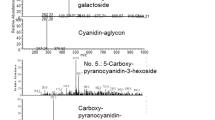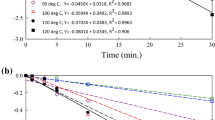Abstract
Changes in betacyanin content and colour shade of juices from purple pitaya [Hylocereus polyrhizus (Weber) Britton & Rose] as affected by thermal processing and consecutive cold storage to allow pigment reconstitution were investigated. Pigments from purple pitaya displayed higher stability than earlier investigations on betalains suggested. A novel high-performance liquid chromatography method was established, allowing simultaneous detection of genuine pigments of purple pitaya juice together with their degradation products. In addition to previously described betanin cleavage products (betalamic acid, cyclo-dopa 5-O-β-glucoside) further degradation products generated after decarboxylation and/or dehydration of phyllocactin and hylocerenin, respectively, were found. Moreover, neobetanin was identified as a thermal degradation product of betanin for the first time. With this newly developed high-performance liquid chromatography method, heating of purple pitaya juice and a commercial pitaya juice concentrate was proven by the detection of thermal betacyanin degradation products that had not been described, so far.





Similar content being viewed by others
References
Pszczola DE (2003) Food Technol 57:52–63
Sloan AE (2003) Food Technol 57:26–36
(a) Stintzing FC, Schieber A, Carle R (2002) Food Chem 77:101–106: (b) Stintzing FC, Schieber A, Carle R (2002) Food Chem 77:517
Stintzing FC, Conrad J, Klaiber I, Beifuss U, Carle R (2004) Phytochemistry 65:415–422
Wybraniec S, Platzner I, Geresh S, Gottlieb HE, Haimberg M, Mogilnitzki M, Mizrahi Y (2001) Phytochemistry 58:1209–1212
Wybraniec S, Mizrahi Y (2002) J Agric Food Chem 50:6086–6089
Czapski J (1985) Z Lebensm Unters Forsch 180:21–25
Czapski J (1990) Z Lebensm Unters Forsch 191:275–278
Havlíková L, Míková K, Kyzlink V (1983) Z Lebensm Unters Forsch 177:247–250
Saguy I (1979) J Food Sci 44:1554–1555
von Elbe JH, Maing I-Y, Amundson, CH (1974) J Food Sci 39:334–337
von Elbe JH, Schwartz SJ, Hildenbrand BE (1981) J Food Sci 46:1713–1715
Castellar R, Obón JM, Alacid M, Fernández-López JA (2003) J Agric Food Chem 51:2772–2776
Merin U, Gagel S, Popel G, Bernstein S, Rosenthal I (1987) J Food Sci 52:485–486
Turker N, Coskuner Y, Ekiz I, Aksay S, Karababa E (2001) Eur Food Res Technol 212:213–216
Schliemann W, Strack D (1998) Phytochemistry 49:585–588
Mégard D (1993) Foods Food Ingred J 158:130–150
Huang AS, von Elbe JH (1985) J Food Sci 50:1115–1120
Cai YZ, Corke H (1999) J Food Sci 64:869–873
Wyler H, Meuer U (1979) Helv Chim Acta 62:1330–1339
Stintzing FC, Schieber A, Carle R (2003) Eur Food Res Technol 216:303–311
Saguy I, Kopelman IJ, Mizrahi S (1978) J Agric Food Chem 26:360–362
Huang AS, von Elbe JH (1987) J Food Sci 52:1689–1693
Schwartz SJ, von Elbe JH (1983) Z Lebensm Unters Forsch 176:448–453
Stintzing FC, Kammerer D, Schieber A, Adama H, Nacoulma OG, Carle R (2004) Z Naturforsch C Biosci 59:1–8
Minale L, Piattelli M, Nicolaus RA (1965) Rend Accad Sci Fis Mater 32:165–172
Hilpert H, Siegfried M-A, Dreiding AS (1985) Helv Chim Acta 68:1670–1678
Strack D, Engel U, Wray V (1987) Phytochemistry 26:2399–2400
Alard D, Wray V, Grotjahn L, Reznik H, Strack D (1985) Phytochemistry 24:2383–2385
Kujala T, Loponen J, Pihlaja K (2001) Z Naturforsch C Biosci 56:343–348
Wyler H (1986) Phytochemistry 25:2238
Kobayashi N, Schmidt J, Wray V, Schliemann W (2001) Phytochemistry 56:429–436
Acknowledgements
The authors wish to thank IngredienTrade New York, USA, for providing Red Pitahaya concentrate. E. Müssig is gratefully acknowledged for the careful isolation of betanin.
Author information
Authors and Affiliations
Corresponding author
Rights and permissions
About this article
Cite this article
M. Herbach, K., C. Stintzing, F. & Carle, R. Thermal degradation of betacyanins in juices from purple pitaya [Hylocereus polyrhizus (Weber) Britton & Rose] monitored by high-performance liquid chromatography–tandem mass spectometric analyses. Eur Food Res Technol 219, 377–385 (2004). https://doi.org/10.1007/s00217-004-0948-8
Received:
Published:
Issue Date:
DOI: https://doi.org/10.1007/s00217-004-0948-8




